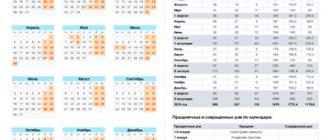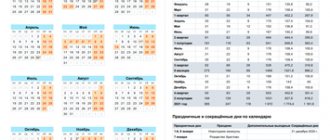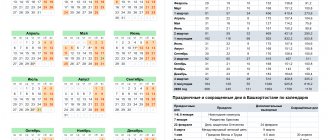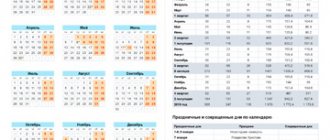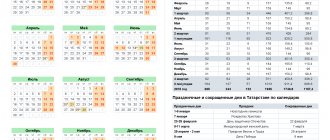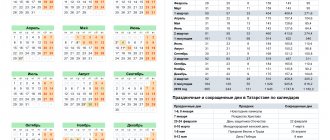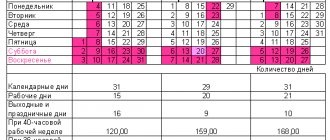General information about the production calendar
There are a total of 365 calendar days in 2022. However, there are quite a few holidays in Russia. They also include weekends (with a six-day work week - Sunday). How not to get confused and correctly distribute working time norms during the “six-day work week”? Moreover, if we are talking about accounting, then working days, holidays and weekends must be taken into account when calculating vacation pay, travel allowances and when preparing reports. For this purpose, the production calendar for 2022 is being formed with a six-day working week.
Production calendar: what is it for?
The concept of “production calendar” is inextricably linked with working time. After all, the production calendar marks all working and non-working days (weekends and holidays). Based on the production calendar, employers (organizations and individual entrepreneurs) can organize the working hours of their employees in 2022.
The production calendar contains both general quarterly information about the number of working days and days off, as well as information for each month. Such information allows you to calculate wages, pay sick leave, calculate vacation or draw up a work schedule. Employees, in turn, can choose the most favorable period for vacation. In other words, the production calendar for 2022 is a universal document that can become the basis for the rational distribution of working time and for maintaining a time sheet in the next year.
Such a concept as “production calendar” is not disclosed in the legislation of the Russian Federation. Therefore, “popularly” it is called differently. So, for example, there are such variations:
- calendar of working days;
- time calendar;
- labor calendar;
- work calendar;
- working time calendar;
- working hours calendar;
- annual working time calendar;
What does the Labor Code of the Russian Federation say about non-working days?
Non-working holidays in the Russian Federation are:
- January 1, 2, 3, 4, 5, 6 and 8 – New Year;
- January 7 – Christmas;
- February 23 – Defender of the Fatherland Day;
- March 8 – International Women's Day;
- May 1 – Spring and Labor Day;
- May 9 – Victory Day;
- June 12 – Russia Day;
- November 4 is National Unity Day.
This list of non-working holidays is fixed and does not change from year to year. It is enshrined in Article 112 of the Labor Code of the Russian Federation.
Non-working holidays in 2018
Non-working holidays in Russia are:
- January 1, 2, 3, 4, 5, 6 and 8 – New Year;
- January 7 – Christmas;
- February 23 – Defender of the Fatherland Day;
- March 8 – International Women's Day;
- May 1 – Spring and Labor Day;
- May 9 – Victory Day;
- June 12 – Russia Day;
- November 4 is National Unity Day.
This list of non-working holidays is fixed and does not change from year to year. It is enshrined in Article 112 of the Labor Code of the Russian Federation.
Regional legislation may establish additional non-working holidays in addition to the all-Russian ones (Part 1 of Article 6 of the Labor Code of the Russian Federation, Resolution of the Presidium of the Supreme Court of the Russian Federation dated December 21, 2011 No. 20-ПВ11).
All these dates are included in the 2018 production calendar with holidays and weekends. Moreover, according to the rules of Article 112 of the Labor Code of the Russian Federation, a holiday that coincides with a weekend is “shifted” to the working day immediately following the holiday. In 2022, such a day is Sunday, November 4, which means that Monday, November 5 will be a non-working day.
There is an exception for New Year's “vacations”: days from January 1 to January 8, coinciding with weekends, can be transferred not to the next day, but to other days of the year. Usually they are added to other holidays, thereby “lengthening” them and changing the calendar of working days.
What transfers to 2022 do not apply to the six-day period?
Article 112 of the Labor Code of the Russian Federation provides that the transfer of days off is carried out for the purpose of rational planning of working time in organizations and taking into account the interests of various categories of citizens of the Russian Federation in creating conditions for proper rest. For these purposes, Decree of the Government of the Russian Federation of October 14, 2022 No. 1250 “On the transfer of weekends in 2022” provides for the following shift of weekends:
Thus, the following weekends have been moved to 2022:
- Saturday 6 January to Friday 9 March;
- Sunday 7 January to Wednesday 2 May.
- Also, to optimize rest time, weekends have been swapped with working days (Saturdays will be working days, and Mondays will be days off):
- Saturday 28 April to Monday 30 April;
- Saturday 9 June to Monday 11 June;
- Saturday 29 December to Monday 31 December.
One holiday - May 9, 2022, in honor of Victory Day, will be a midweek holiday.
In a six-day work week, Saturdays are not days off, which means that these transfers are not provided for a six-day work week.
For those working on a six-day week, March 9, April 30, June 11 and December 31, 2022 will remain working days, since the transfer of weekends to these dates is planned from Saturdays that coincide with non-working holidays, and for the “six-day week” Saturday is not a day off.
“New Year holidays” for those working on a “six-day week” will last from January 1 to January 8, 2022.
Due to the postponement of January 7 to May 2, workers with a six-day working week in 2022 will have two consecutive days off for the May holidays - May 1 - 2.
Shortened working days with a reduction in working hours by one hour in 2022 for six-day workers will be February 22, March 7, April 30, May 8, June 11, November 3, December 31.
Production calendar for 2022 six days
By Decree of the Government of the Russian Federation dated October 14, 2017 No. 1250, the following days off were postponed in 2022:
- Saturday January 6 to Friday March 9 (for a six-day period this transfer does not matter - March 9 will be a regular working day);
- Sunday 7 January to Wednesday 2 May.
The Government also moved the weekend from Saturdays April 28, June 9 and December 29 to Mondays April 30, June 11 and December 31, respectively. However, with a six-day work week, Saturdays are not days off, which means that these transfers are not provided for a six-day work week.
Production calendar for 2022 with a six-day week
Here is the production calendar for 2022 with a six-day working week:
Below we present a quarterly production calendar for a six-day work week (with weekends and holidays). Taking into account all the transfers, the production calendar for a six-day working week will look like this (pre-holiday days, when the working day is reduced by 1 hour, are marked with an asterisk*):
.
Working time standards for 2022 in the production calendar
So, all norms for the number of weekends and working days, as well as the number of working hours for 40-, 36-, 24-hour work weeks can be combined into one visual table:
| Period | Amount of days | Working hours per week | ||||
| Calendar | workers | Weekends | 40 hours | 36 hours | 24 hours | |
| January | 31 | 17 | 14 | 136 | 122,4 | 81,6 |
| February | 28 | 19 | 9 | 151 | 135,8 | 90,2 |
| March | 31 | 20 | 11 | 159 | 143 | 95 |
| 1st quarter | 90 | 56 | 34 | 446 | 401,2 | 266,8 |
| April | 30 | 21 | 9 | 167 | 150,2 | 99,8 |
| May | 31 | 20 | 11 | 159 | 143 | 95 |
| June | 30 | 20 | 10 | 159 | 143 | 95 |
| 2nd quarter | 91 | 61 | 30 | 485 | 436,2 | 289,8 |
| 1st half of the year | 181 | 117 | 64 | 931 | 837,4 | 556,6 |
| July | 31 | 22 | 9 | 176 | 158,4 | 105,6 |
| August | 31 | 23 | 8 | 184 | 165,6 | 110,4 |
| September | 30 | 20 | 10 | 160 | 144 | 96 |
| 3rd quarter | 92 | 65 | 27 | 520 | 468 | 312 |
| 9 months | 273 | 182 | 91 | 1451 | 1305,4 | 868,6 |
| October | 31 | 23 | 8 | 184 | 165,6 | 110,4 |
| November | 30 | 21 | 9 | 168 | 151,2 | 100,8 |
| December | 31 | 21 | 10 | 167 | 150,2 | 99,8 |
| 4th quarter | 92 | 65 | 27 | 519 | 467 | 311 |
| 2nd half | 184 | 130 | 54 | 1039 | 935 | 623 |
| 2018 | 365 | 247 | 118 | 1970 | 1772,4 | 1179,6 |
FILES
Clarifications on working time standards
Art. Art. 91 and 92 of the Labor Code of the Russian Federation standardize the working hours for certain categories of workers:
- generally accepted - 40-hour work week;
- for company employees under 16 years old – up to 24 hours/week;
- from 16 to 18 years – up to 35 hours/week;
- for disabled people of 1st and 2nd degree – up to 35 hours/week;
- for workers in hazardous and heavy industries – up to 36 hours/week.
There are also special regimes for students and part-time workers. According to the Labor Code of the Russian Federation and Order of the Ministry of Health and Social Development No. 588n dated August 13, 2009, any company by collective agreement can establish a different working time, which cannot exceed the maximum established by the Labor Code.
Important!
- In organizations with summarized time recording for periods equal to a month or a year or another period of time, their daily, weekly and monthly norms are calculated based on the work period norms established in the Labor Code of the Russian Federation.
- When accounting for overtime in aggregate, work on holidays and weekends included in this period will not be recognized. This is considered to be overtime processing.
- So, if the period is the 3rd quarter of 2022, then the norm will be 520 hours. This means that overtime is recognized as time worked from 521 hours.
- It is worth noting that there will be no violation of the Labor Code of the Russian Federation in this case, since payment for work on holidays/weekends will have to be made in double amount.
But in any case, the daily rate is calculated from the standard assumption about the length of the week - 5/2. Even if the organization is on a 6-day schedule. The norm is calculated by dividing the weekly time by 5:
- 40 hours / 5 = 8 hours
- 36h. / 5 = 7.2 hours.
- 24 hours / 5 = 4.8 hours
- And so on.
The standard version of the production calendar takes into account all working time standards provided for by the Labor Code of the Russian Federation. The accountant can only find out the category of the employee in order to calculate his salary.
The monthly norm (MN) is calculated based on the daily norm (DN):
DN* number of working days in a month = MN,
if a reduction in working hours is expected in a month due to a subsequent holiday, then the number of hours of reduction is subtracted from the MT.
For example, the monthly working hours in November 2022 with a 5-day (40-hour) week:
(40 hours / 5)* 21 = 8*21 = 168 hours.
The annual working hours are calculated using the formula:
DN* number of working days in a year – “decreasing” hours.
Standard working hours for a six-day week
In accordance with Article 100 of the Labor Code of the Russian Federation, a number of organizations and enterprises establish a six-day working week with one day off for their employees. The general day off is Sunday (Article 111 of the Labor Code of the Russian Federation).
The normal working hours for a six-day working week, as well as for a five-day one, cannot exceed 40 hours per week (Article 91 of the Labor Code of the Russian Federation).
For a six-day working week in accordance with the Procedure, approved. By Order of the Ministry of Health and Social Development of Russia dated August 13, 2009 N 588n, the standard working time is also calculated according to the calculated schedule of a five-day work week with two days off on Saturday and Sunday, based on the duration of daily work (shift).
In accordance with Part 1 of Article 95 of the Labor Code of the Russian Federation, the duration of the working day or shift immediately preceding a non-working holiday is reduced by one hour. With a 6-day working week on the eve of the weekend, the duration of work cannot exceed 5 hours (part three of Article 95 of the Labor Code of the Russian Federation).
The standard working time calculated in the specified order applies to all work and rest regimes.
How holidays are rescheduled in 2018
Article 112 of the Labor Code of the Russian Federation establishes that the transfer of days off is carried out for the purpose of rational planning of working time in organizations and taking into account the interests of various categories of citizens of the Russian Federation in creating conditions for proper rest. For these purposes, Decree of the Government of the Russian Federation of October 14, 2022 No. 1250 “On the transfer of weekends in 2022” provides for the following shift of weekends:
Also see Calendar 2022.
As you can see, the weekends of January 6 and 7 (Saturday and Sunday) 2018, coinciding with non-working holidays, have been moved to March 9 and May 2, respectively. Rest days from Saturday 28 April, Saturday 9 June and Saturday 29 December have been moved to Monday 30 April, Monday 11 June and Monday 31 December respectively. Taking into account such transfers, the 2022 calendar includes six long weekends and holidays:
- from December 30, 2022 to January 8, 2022 inclusive (10 days of New Year holidays);
- from February 23 to 25 (3 days on Defender of the Fatherland Day);
- from March 8 to 11 (4 days - International Women's Day);
- from April 29 to May 2 (4 days – Spring and Labor Festival);
- from June 10 to 12 (3 days – Russia Day);
- from November 3 to 5 (3 days - National Unity Day).
One holiday - May 9, 2022, in honor of Victory Day, will be a midweek holiday.
There will be three working Saturdays in 2022 - April 28, June 9 and December 29.
